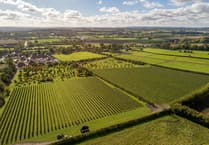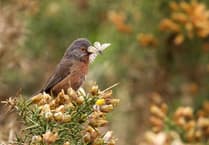Among winter’s wonderful sights are the birds which spend their winter holidays in the UK.
The exotic-looking waxwing is a bird to look out for this month. They breed in northern forests and are more usually found in Scandinavia and northern Russia, but small numbers visit the UK every winter, with flocks crossing the North Sea in a quest for berries – their favourite food.
This winter large numbers of waxwings have made the crossing in what is termed an “irruption”. The birds are first seen on the east coast before moving farther inland. Birdwatchers report they’ve seen waxwings gorging on berries in Farnham and East Horsley recently, so it’s possible they’ll be spotted in the Woking area too.
Waxwings prefer rowan and hawthorn berries, but can be enticed with hung-up apples.
They are about the size of a starling, but their punk-rocker crest makes them really stand out. They are reddish-brown with a black throat, a small black mask round the eyes, yellow and white in the wings and a yellow-tipped tail. It’s said they were named waxwings because the tips of their feathers look as though they’ve been dipped in sealing wax.
They can be spotted individually or in flocks on bushes full of berries. They’re not fussy where they feed, even in busy car parks and gardens.
The redwing is another winter visitor to look out for. It is in the thrush family, but has distinctive orangey-red patches under its wings. Elsewhere they are dark brown above and white below, with a black-streaked breast. It has a distinctive face too, with a white eyebrow stripe and dark brown cheeks.
Redwings are common visitors to the UK each winter, coming mainly from Iceland and Scandinavia to enjoy the feast of seasonal berries in the UK’s hedgerows, gardens and parks.
Over the winters I’ve often seen large groups of these distinctive birds on broad grassy areas alongside footpaths near my Goldsworth Park, Woking, home. They seem to be oblivious to human passers-by as they busily gorge on berries or explore the turf for wriggly feasts.
The numbers of redwings in any year depends on food availability in their northern breeding territories during the spring and summer. In autumn, redwings gather along the Scandinavian coast at dusk before launching off on their 500-mile overnight flight across the North Sea to the UK.
Another winter thrush to look for is the fieldfare – the largest thrush seen in the UK and distinguished from others by its grey head and yellow bill. They stand very upright and move forward with purposeful hops. They are very social, spending the winter in flocks of anything up to several hundred strong.
Like redwings, these birds are come to the UK seeking food and shelter in our warmer climate. They arrive from Scandinavia, Russia and Eastern Europe to spend the winter here.
If you spot any of these attractive winter visitors, take a moment to observe them while they’re here because, when spring arrives, they’ll leave us to return to their northern breeding grounds.
And please tell us what you’ve seen by email to [email protected]




